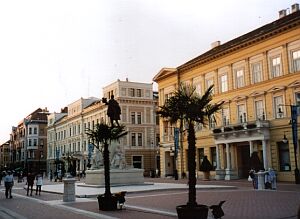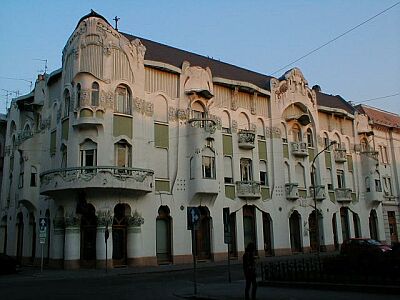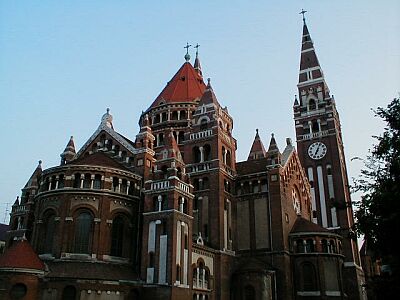Official Name
Szeged. In the Austro-Hungarian monarchy, Szeged was also known under its German name Szegedin (famous for a dish called Szegedin Goulash). In Roman times, the settlement was called Partiscum.
Location

| ||
| Szeged |
Szeged is located in the Southern Great Plain right at the confluence between the river Maros and the Tisza (Theiss). The latter comes from the Forest Carpathian Mountains in the →Ukraine and flows into the river Danube in Serbia. The border to →Serbia in the south as well as the border to →Romania in the south-east are only a few km away. To →Budapest in the north it's more than 150 km.
Population
Around 170,000 - Szeged is one of the biggest towns in Hungary.
Orientation
Szeged stretches along the right (western) bank of the river Tisza. The central, rectangular square is called Széchenyi tér (tér = square). This square is rather large and not far from the rivershore. Some radial roads surround the square semicircularly - the biggest of them is divided into several segments. The segments are named after some European cities, and so there's a Rome, Brussels, Berlin, Paris, London, Moscow and Viennese Ring.

| ||
| The pedestrian zone Mikszáth Kálmán utca |
There's a good reason for this. Those are the capitals of the countries that helped to rebuilt the town after the 'Great Water' (see the chapter on history below). After the flood, the town was rebuilt within a few years. Modern (and interesting) urban development was applied consequently, and so Szeged is very homogeneous, which is quite unusual for a Hungarian town. There's a lot of green in the spacious town centre as well as along the river Tisza. From the central square, Mikszáth Kálmán utca runs north-eastwards. It's a vibrant pedestrian zone with many shops. Running to the south-east, there's the Híd utca (Bridge St), leading straight to the Belvárosi híd (Inner city bridge). The tourist information can be found halway on the right side. When you cross the bridge, you will eventually enter the new town.
The train station is quite far away from the centre in the southern suburbs. However, tram No 1 runs straight to the station. The bus station is much closer - it's located at the end of the pedestrian zone Mars tér.
History
Szeged was already founded in Roman times and known as Partiscum. Excavations showed, that king Attila might have ruled his short-lived Kingdom of the Huns from Szeged. For many centuries, the town was an important local centre. After the 13th century, Szeged became a trade centre. This shouldn't even change during the Ottoman occupation. One of the reasons for the quick development of the town might be the location at the confluence of Maros and Tisza. Goods were easy to transport and the city itself was easy to protect. But the location was also fatal. In the year 1879, a huge wave rolled downstream the river Tisza and virtually washed away the entire city within one night. This desastrous event is simply referred to as 'the Great Water' by the locals.
Soon after the flood, an impressive wave of international solidarity swept over the city, and so Szeged rose like a phoenix from the ashes. Everything was completely remodelled, including the layout of the streets. Architects from many different countries helped to rebuilt the town and left their characteristic traces. After the Second World War, a university was founded. Today, visitors will soon notice that they are in a university town.
Getting there / transportation
Many buses and trains connect Szeged with the rest of the country. Several trains a day run to →Budapest Nyugati (1,500 Ft., around 2½ hrs). There are also local trains to Subotica in →Serbia. When going to →Pécs in Western Hungary, it's better to take the bus (1,820 Ft., around 3 hrs). The same can be said about trips to Arad and Timişoara in →Romania.
Due to the big flood desaster, not many houses built before the year 1879 are left. Which doesn't matter, since many of the buildings built after the flood are impressive, too. My personal favourite in Szeged is the Reök Palace, which was built in 1907 (it faces Kölcsey utca) and is a masterpiece of the Art Nouveau style, see picture below). Today, the 'palace' houses a bank. The interior of the palace is even more impressive than the outside!

| ||
| The Art Noveau style Reök-Palast in Szeged |
In contradiction to that, the Votive Church in the southern part of the centre is surprisingly ugly, The construction of the church was started right after the big flood, but it wasn't completed before 1930. The twin-towered monstrosity looks like a gingerbread fortress.

| ||
| Votive Church in the centre of Szeged |
Right behind the Votive Church there's the Serbian-Orthodox Church, which was built in 1778. It's one of a few buildings that managed to survive the flood without greater damage. The interior features an impressive iconostasis. Another interesting building is the Great Synagogue from the year 1903. Some people say that it's not less than Hungary's most beautiful Synagogue.
Besides that, Szeged is famous for two other things: The so-called Szegedin Goulash (some sort of hot stew with cabbage) and Pick-Salami - Hungary's most famous salami.
Private accommodation, hotels, students' dormitories etc - everything is possible. Between July and August it's possible to stay in one of the dormitories. One of them is the nice Loránd Eötvös College at the southern edge of the city centre opposite the Votive Church. Well, inside it looks like a typical students' dorm. The price for one person a night is 1,850 Ft only. Here's the address: Tisza Lajos körüt 103, Tel.: 310 641.
- www.visitors.hu/07_07_en.html Interesting website about Szeged, with some pictures. Here's the English version.
- szeged.ohb.hu Website of the town with travel information and hotel tips.
Do you have or do you know a good website about Szeged? Don't hesitate, let me know! After checking it, I would love to add it to the link list. You can submit a link by using the →contact form. Note that commercial websites will be treated differently.
©2024 Europe-East.com

 Albania
Albania Hungary
Hungary